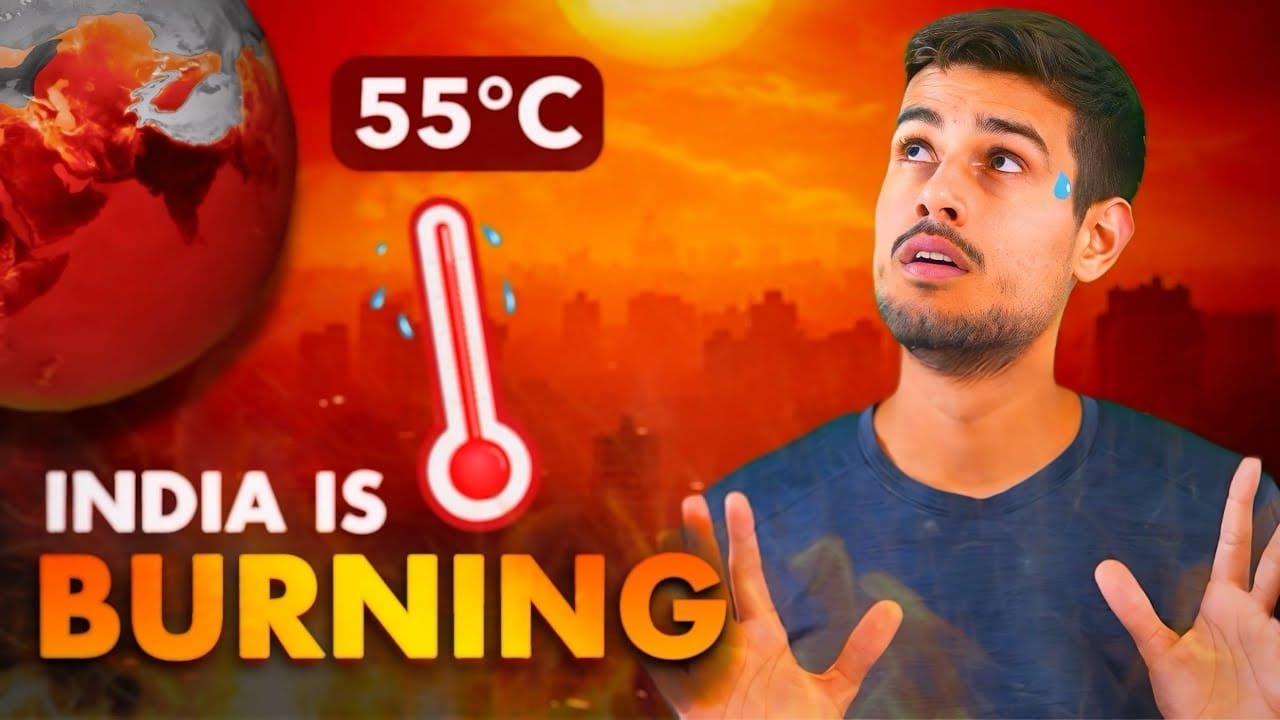
Dhruv Rathee’s latest video provides an in-depth and informative exploration of the extreme weather events and unprecedented heat waves affecting the globe. Rathee’s thorough explanation not only covers the alarming statistics but also delves into the underlying causes and potential solutions to mitigate the impacts of these phenomena. His ability to break down complex scientific concepts into simple terms is commendable, making it accessible for a wide audience. Here, we will summarize and appreciate the key points discussed by Dhruv Rathee in his video, highlighting the significant issues and proposed solutions.
Record-Breaking Heat and Climate Change
Dhruv Rathee begins by discussing the increasingly severe heatwaves that have plagued the world over the past few years. In 2022, India experienced the hottest summer ever recorded, breaking a 122-year-old record. The following year, 2023, was even more extreme, with scientists declaring it the hottest summer in the last 2,000 years in the northern hemisphere. This alarming trend continued into 2024, with each month from January to April breaking temperature records, culminating in April being the hottest month ever recorded on Earth.
Rathee emphasizes that this relentless increase in temperatures is not just a local phenomenon but a global crisis. The last 11 months have been particularly scorching, affecting not only India but also Southeast Asia and other regions around the world. He highlights the devastating impact of these heatwaves, such as the heat index in the Philippines crossing a deadly 53°C, and forest fires ravaging various parts of India, including Uttarakhand, Odisha, Chhattisgarh, Madhya Pradesh, and Jharkhand.
Global Impacts of Extreme Weather
Rathee expands the discussion to a global scale, illustrating how extreme weather events are becoming more frequent and intense due to climate change. In South America, particularly Brazil, unprecedented floods displaced over 150,000 people and resulted in significant loss of life. Meanwhile, Southern Africa is grappling with a severe drought, the worst since 1947, pushing many families into starvation and prompting a request for $5.5 billion in aid to prevent widespread famine.
The Role of El Niño and La Niña
A significant portion of Rathee’s video is dedicated to explaining the El Niño Southern Oscillation (ENSO) cycle, which includes both El Niño and La Niña events. El Niño, characterized by the warming of surface waters in the Pacific Ocean, leads to significant changes in global weather patterns. Trade Winds, which usually blow from east to west, weaken during El Niño, causing warmer waters to stay near South America and leading to increased rainfall and flooding in that region. Conversely, Australia and Southeast Asia experience higher temperatures and drier conditions, increasing the risk of heatwaves and wildfires.
La Niña, the opposite phenomenon, strengthens the Trade Winds, resulting in colder water near South America and warmer water near Australia, which increases rainfall in Australia and can lead to flooding. Rathee points out that the most recent El Niño event, starting in 2023, has exacerbated the heatwaves and droughts in various regions, and that the impacts of such events are becoming more severe due to climate change.
Local Solutions to Global Problems
Dhruv Rathee does not just highlight the problems but also suggests practical solutions to mitigate the impacts of extreme heat at a local level. One key strategy he discusses is addressing the Urban Heat Island (UHI) effect. Cities, with their dense concrete structures and asphalt roads, tend to absorb and retain heat, making them significantly hotter than surrounding rural areas. Rathee suggests increasing green spaces within cities, such as parks and tree-lined streets, to help lower temperatures. He cites examples from Delhi, where areas with more greenery were found to be 3°C to 8°C cooler than concrete-dominated areas.
Rathee also advocates for reducing the use of cars, promoting public transportation, and encouraging walking and cycling. He highlights Paris as a model city that has successfully implemented such measures, reducing car usage, increasing greenery, and creating more pedestrian-friendly spaces. This not only helps mitigate the UHI effect but also promotes a healthier, more sustainable urban environment.
Innovative Cooling Solutions
Addressing the challenge of keeping buildings cool without exacerbating the UHI effect, Rathee discusses innovative cooling solutions. One such method is painting rooftops white to reflect sunlight, which can reduce indoor temperatures by 2°C to 3°C. Another approach is installing green roofs, where vegetation is grown on rooftops to provide natural insulation.
He also introduces the concept of Radiant Cooling, a technology where pipes carrying cold water are embedded in walls and ceilings, providing efficient cooling without the need for air conditioners. This method, rooted in ancient architectural practices, offers a sustainable and cost-effective alternative to conventional cooling systems.
Importance of Humidity and Heat Index
Dhruv Rathee emphasizes that temperature alone does not determine the severity of heat; humidity plays a crucial role. High humidity levels make it difficult for sweat to evaporate, impairing the body’s ability to cool down and increasing the risk of heat-related illnesses. Rathee explains the concept of the Heat Index, which combines temperature and humidity to provide a more accurate measure of how hot it feels. He underscores the importance of considering the Heat Index when assessing the danger posed by heatwaves, noting that high humidity can make moderate temperatures feel much hotter and more dangerous.
The Need for Immediate Action
Rathee concludes by stressing the urgency of addressing climate change and its impacts. He highlights a study predicting that by 2050, some regions could experience heatwaves lasting for 220 to 250 days a year. This dire projection underscores the need for immediate and concerted action to mitigate climate change, reduce greenhouse gas emissions, and implement adaptive strategies to cope with extreme weather.
Dhruv Rathee’s video is a comprehensive and enlightening exploration of the extreme heat and its underlying causes. His ability to explain complex scientific concepts in simple terms makes the information accessible to a broad audience. Rathee not only highlights the severity of the problem but also offers practical solutions to mitigate the impacts of extreme heat at both global and local levels.
His advocacy for increased urban greenery, sustainable cooling technologies, and reduced car usage provides a clear roadmap for cities to become more resilient to heatwaves. Moreover, his emphasis on the importance of considering both temperature and humidity in assessing heat risks is a crucial takeaway for public awareness and safety.
In sum, Dhruv Rathee’s video serves as a crucial wake-up call about the escalating impacts of climate change and the urgent need for action. It is an exemplary piece of educational content that informs, engages, and empowers viewers to understand and address one of the most pressing challenges of our time.
